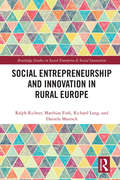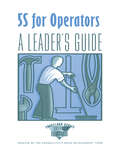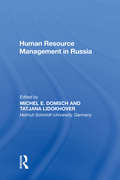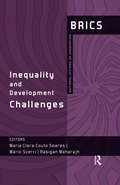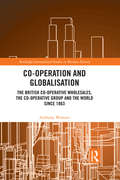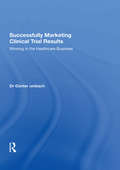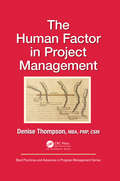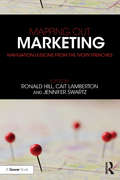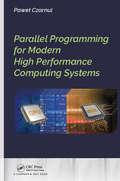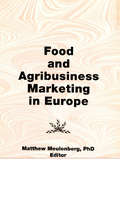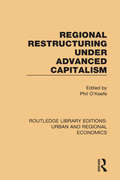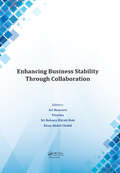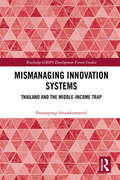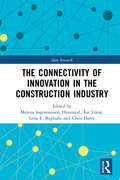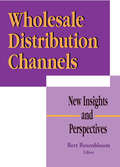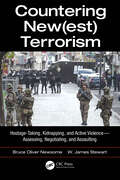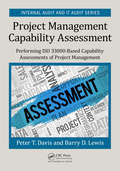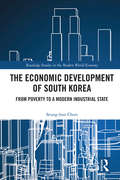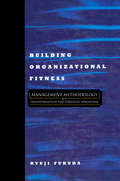- Table View
- List View
Social Entrepreneurship and Innovation in Rural Europe (Routledge Studies in Social Enterprise & Social Innovation)
by Ralph Richter Matthias Fink Richard Lang Daniela MareschSocial Entrepreneurship and Innovation in Rural Europe investigates how social entrepreneurship advances social innovation in rural Europe and contributes to fighting social and economic challenges in these regions. Based on longitudinal data collected in four European countries, this book explains how social enterprises enact their business model based on an entrepreneurial reconfiguration of resources they obtain from their network relations, and how their activities empower local communities, driving change and eventually innovation. In these activities, the entrepreneurial mindset and the role as intermediary between different groups and domains of society help to reframe challenges into opportunities. The argument in this book develops from a description of what social enterprises report to do to an analysis of how they do it, and results in an explanation of why they take these actions. In doing so it gradually broadens the view from a focus on the social enterprises themselves to their interactions and network partners and, finally, to their positioning in societal fields. The presented model complements network theory with the concept of strategic action fields. This book reveals the crucial role of social entrepreneurship in innovation in rural regions, and the rich insights provided have far reaching implications for research, practice and policy. This book will appeal to everyone interested in the interface of social entrepreneurship, innovation, and regional/rural development, either on a practical or academic level.
5S for Operators A Leader's
by Productivity Press Development TeamSort, Set in Order, Shine, Standardize, Sustain. Together, these five simple principles form the basis of the 5S System - a powerful front-line tool for simplifying work processes, improving equipment maintenance, ensuring safety and product quality and eliminating waste. 5S is the basis for any on-the-floor improvement activity and the 5S for Operators Learning Package is a fantastic way to bring that knowledge to the shop floor. Thorough, flexible and almost infinitely customizable, the 5S for Operators Learning Package allows your instructor to conduct learning sessions tailored specifically to your organization. That customizability combined with modules specifically designed to encourage workers to become actively involved in the learning process makes for a high-impact learning experience your workforce won't soon forget. Based on the classic manufacturing text 5 Pillars of the Visual Workplace, the 5S for Operators Learning Package brings that knowledge to the shop floor and will prove to be an excellent support in your companies' continuous improvement efforts.
The Accounts of the British Empire: Capital Flows from 1799 to 1914
by Mario TiberiThe fundamental role of Great Britain's economy in the international economic system in the century preceding the First World War is demonstrated by a number of variables, which have drawn the interest of many scholars. The focus here is on capital flows. The main difficulty encountered in this work arose from a shortage of documentation on economic data in the historical period under consideration, which has been tentatively reconstructed, on the basis of a number of estimates, subjected to a close comparative scrutiny. The book provides a valid guide to anyone wishing to improve their understanding of the so-called "pax britannica" which, at that time, rested on the canons of free trade and the gold standard. This historical period is considered by many to be the first experience of capitalist globalization. In this sense the book is also intended to provide useful reading for those who want to reflect on the possible future evolution of the world economy.
The Case for Gold Vol 1
by William Rees-MoggThe role of gold in the world's exchange system has been hotly contested by leading economists. This work collects the most important arguments in favour of gold, including such works as David Ricardo's "High price of Bullion" and W. Stanley Jevons's "Money and the Mechanism of Exchange".
Human Resource Management in Russia (Contemporary Employment Relations Ser.)
by Michel E. Domsch Tatjana LidokhoverInvestigating Human Resource Management issues in Russia, this volume looks at the current state of Human Resource practice within Russian enterprises; its various problems and possible solutions. Following a detailed introduction into the current economic developments taking place in Russia, the book examines the new role of the HR department in Russian enterprises, and the influence of national politics on HR practice. The book also discusses key HRM issues such as recruitment and selection, training and development, payment and compensation, before surveying the various HR problems encountered by multinational companies working in Russia.
Doing Business in Korea
by Fabian Jintae FroeseMuch of the existing research looks at the outflow of companies and people from Korea to foreign countries, whilst less is known about foreign firms and workers in Korea. Considering the immense interest of both academics and practitioners in the business opportunities in Korea, this book provides a comprehensive overview of doing business in Korea and recommendations on how foreign companies and individuals can succeed in this market. This book covers a wide range of relevant topics, including the Korean business environment, market entry into Korea, management issues and entrepreneurship in Korea. This is a must-read for anyone interested in or already doing business in Korea.
Inequality and Development Challenges: BRICS National Systems of Innovation
by Mario Scerri Maria Clara Couto Soares Rasigan MaharajhThis series of books brings together results of an extensive research programme on aspects of the national systems of innovation (NSI) in the five BRICS countries — Brazil, Russia, India, China, and South Africa. It provides a comprehensive and comparative examination of the challenges and opportunities faced by these dynamic and emerging economies. In discussing the impact of innovation with respect to economic, geopolitical, socio-cultural, institutional, and technological systems, it reveals the possibilities of new development paradigms for equitable and sustainable growth. This volume analyses the co-evolution of inequality and NSI across the BRICS economies. It reveals the multi-dimensional character of inequality, in going beyond its income aspect to include assets, access to basic services, infrastructure, knowledge, race, gender, ethnicity and geographic location. In advancing valuable policy recommendations, the book argues that inequalities must be factored in development strategies given that benefits of innovation are not automatically distributed equally. Original and detailed data, together with expert analyses on wide-ranging issues, make this book an invaluable resource for researchers and scholars in economics, development studies and political science, in addition to policy-makers and development practitioners interested in the BRICS countries.
Co-operation and Globalisation: The British Co-operative Wholesales, the Co-operative Group and the World since 1863 (Routledge International Studies in Business History)
by Anthony WebsterGlobalisation is associated with capitalist multinationals dedicated to the enrichment of wealthy, corporate shareholders. However, less well known is that the English and Scottish Co-operative Wholesale Societies, owned by the growing number of local co-operative societies across the country, were early leaders in global commerce. Owned by their working-class members, by 1900 there were over 1,000 societies and millions of individual members. Spreading profits widely through the ‘divi’ which rewarded members shopping at the co-op store, and selling safe and wholesome food, the co-operative movement was a successful part of the emerging labour movement. This success depended on the wholesale societies supplying societies with commodities from all over the world. Because local societies were free to source produce from whoever they chose, competitive pressures required the wholesale societies to develop the world’s most formidable network of international supply chains, with branches, depots, plantations and factories in the USA, Canada, Denmark, Sweden, Spain, Greece, France, Germany, India, Ceylon, Australia, New Zealand, colonial West Africa and Argentina. This book explains how the wholesales developed and managed these networks, giving them a competitive advantage in their dealings with the local societies. It will explore why and how this ‘People’s Global Colossus’ declined in the later 20th century, and how its focus in international commerce moved onto ethical sourcing, investment and Fair Trade. Integral to these global networks were the UK movement’s relations with foreign co-operative movements, especially through involvement in the International Co-operative Alliance, and promotion of co-operatives in the Empire by successive British governments as a tool for economic development. The ‘People’s Colossus’ was thus a political as well as a commercial player in the increasingly complex world of the late 19th and 20th centuries.
Successfully Marketing Clinical Trial Results: Winning in the Healthcare Business
by Günter UmbachIn the US alone, pharmaceutical companies spend around $7 billion a year on clinical trials for drugs; all this in a global market where increasing competition and pressure on healthcare financing are both impacting on margins and profitability. One solution for pharmaceutical companies lies within the clinical trials themselves. If only you can communicate the trial findings to the right people, in the right way, you can benefit from this huge investment and add significant value to your product range and your brand. Successfully Marketing Clinical Trials Results is a comprehensive guide for every marketing professional faced with the challenge of using marketing to convert scientific data into sales. The book offers you practical knowledge on how to use medical research data to maximise the revenue from your products. There are sections explaining how to: � identify your market and devise your strategy; � develop your content and translate data into a message that has impact; � use language, layout and illustrations to best effect; � communicate internally as well as externally; � make best use of the resources available; � align your sales force and the external agencies with whom you work; � lead the people in the project team; � co-operate with the medical researchers, external experts and the press. In this book are answers for everything from how to handle class-effect questions to developing a shared brand vocabulary. There are plenty of vivid examples and real-life applications to reinforce the ideas. Cases studies illustrate solutions to problems; checklists and tips will help to implement the suggestions and recommendations. Günter Umbach has distilled the essence both of 25 years' experience in the healthcare market and of his highly successful seminar series on marketing clinical trials into the professional advice given in this book. The text is accompanied by a CD ROM containing detailed Powerpoint slides supporting e
The Human Factor in Project Management (Best Practices in Portfolio, Program, and Project Management)
by Denise ThompsonIn the fluid world of changing business environments and variables affecting projects, a style of project management that primarily relies on maintaining the Iron Triangle, that tenuous mix of schedule, scope, and budgets, is no longer the sole path to success. Today’s project management demands a focus on leadership of the kind that anticipates and embraces change, challenges the status quo, and inspires teams. Developing these skills requires a mastery of emotional intelligence, courage, critical thinking, and a desire to become a true leader dedicated to developing success. Whether you are participating in a project for the first time or you’ve been doing projects for decades, you know the very essence of a project is to return value that gains a competitive edge and propels the organization forward into new frontiers. Whether you believe the best results are earned through agile, waterfall, or a mix of methodologies, project leadership is the secret weapon that will maintain and grow professional relevance, knowledge, and value in today’s workforce. Through a series of notable lessons in human history and behavior, The Human Factor in Project Management takes you on a journey of self-discovery to define your capabilities and gaps, while building your leadership skills. In your role as a project manager, project sponsor, product owner, or champion, the book challenges you to question the choices you make in a series of stories where you are the main character. This guide to career and personal growth forces you to look beyond the limitations of a Gantt chart, spreadsheet, or a Kanban board to evaluate the value from every tool you use and every action you take.
Mapping Out Marketing: Navigation Lessons from the Ivory Trenches
by Ronald Hill, Cait Lamberton and Jennifer SwartzSea-changes in society, technology, consumer expectations and our understanding of behavioral economics have caused us to rethink our understanding of the scope of knowledge required to navigate, analyze and shape consumer behavior. You hold in your hand a field guide for this adventure. Ron Hill and Cait Lamberton have gathered together the very top professors from around the world and invited them to share the beliefs, practices and wisdom that they have developed and honed across years and contexts. Each of these luminaries shares personal stories and deep insights about the way that not only business works, but the way we, ourselves, navigate the world. These short contributions are contained in eight "destinations" that showcase overlapping and essential topics, ranging from technology to subsistence marketplaces, followed by unique questions that are answered by the material provided. The research described has helped the field understand the central role of exchange in marketing relationships, and how product features, pricing strategies, delivery mechanism and various communication modalities create or fail to produce functioning marketplaces around the world. In addition, it reminds us all of the need to continue to learn, to grow, and to share our knowledge – in whatever corner of the marketing world we find ourselves.
Labour Unionism in the Financial Services Sector: Fighting for Rights and Representation
by Gregor GallIn recent years, there has been an acute crisis of worker representation in the finance sector in Britain. Labour union and staff association membership and density has fallen, collective organisation has experienced dislocation and disorganisation and worker self-confidence has been sapped. Prior to this, there was a sense of an identifiable trajectory towards greater 'unionateness' by labour unions and staff associations, with the sector moving towards growing self-identification of employees as 'workers' and the use of traditional tools of collective bargaining such as threats of strikes and strikes themselves. This study documents and explains these changes in wider historical terms, providing invaluable reading for those interested in the future of both the labour movement and the finance sector.
Renewable Energy: Four Volume Set (Earthscan Reference Collections)
by Bent SørensenThis four-volume set, edited by a leading expert in the field, brings together in one collection a series of papers that have been fundamental to the development of renewable energy as a defined discipline. Some of the papers were first published many years ago, but they remain classics in their fields and retain their relevance to the understanding of current issues. The papers have been selected with the assistance of an eminent international editorial board. The set includes a general introduction and each volume is introduced by a new overview essay, placing the selected papers in context. The range of subject matter is considerable, including coverage of all the main renewable technologies, the fundamental principles by which they function, and the issues around their deployment such as planning, integration and socio-economic assessment. Overall, the set provides students, teachers and researchers, confronted with thousands of journal articles, book chapters and grey literature stretching back decades, with a ready-made selection of and commentary on the most important key writings in renewable energy. It will be an essential reference for libraries concerned with energy, technology and the environment.
Parallel Programming for Modern High Performance Computing Systems
by Pawel CzarnulIn view of the growing presence and popularity of multicore and manycore processors, accelerators, and coprocessors, as well as clusters using such computing devices, the development of efficient parallel applications has become a key challenge to be able to exploit the performance of such systems. This book covers the scope of parallel programming for modern high performance computing systems. It first discusses selected and popular state-of-the-art computing devices and systems available today, These include multicore CPUs, manycore (co)processors, such as Intel Xeon Phi, accelerators, such as GPUs, and clusters, as well as programming models supported on these platforms. It next introduces parallelization through important programming paradigms, such as master-slave, geometric Single Program Multiple Data (SPMD) and divide-and-conquer. The practical and useful elements of the most popular and important APIs for programming parallel HPC systems are discussed, including MPI, OpenMP, Pthreads, CUDA, OpenCL, and OpenACC. It also demonstrates, through selected code listings, how selected APIs can be used to implement important programming paradigms. Furthermore, it shows how the codes can be compiled and executed in a Linux environment. The book also presents hybrid codes that integrate selected APIs for potentially multi-level parallelization and utilization of heterogeneous resources, and it shows how to use modern elements of these APIs. Selected optimization techniques are also included, such as overlapping communication and computations implemented using various APIs. Features: Discusses the popular and currently available computing devices and cluster systems Includes typical paradigms used in parallel programs Explores popular APIs for programming parallel applications Provides code templates that can be used for implementation of paradigms Provides hybrid code examples allowing multi-level parallelization Covers the optimization of parallel programs
Food and Agribusiness Marketing in Europe
by Erdener Kaynak Matthew MeulenbergThis groundbreaking book is the first to provide state-of-the-art information on the current changes and developments in European food and agricultural marketing. Food and Agribusiness Marketing in Europe contains broad and up-to-date coverage of agricultural and food marketing by experts in a variety of European countries including Germany, Greece, Italy, the United Kingdom, France, Ireland, Belgium, the Netherlands, Spain, and Hungary. With chapters selected by the famous marketing specialist Matthew Meulenberg of The Netherlands, this enlightening book allows food and marketing professionals to gain new perspectives on the changing roles of food retailing and food industry in agricultural marketing and the structure of agriculture and food markets.This insightful book introduces readers to the common factors influencing European food marketing today including the stagnating volume of food demand, severe competition between suppliers of agricultural and food products, the overall shift in agricultural marketing towards more market-consumer orientation, and the resulting concern about product development, branding, and customer relationships. Major national differences in food and agricultural marketing in each country are also analyzed, in particular, the problems of implementing European Community legislation in the face of tremendous divergences among member countries in their needs, expectations, and priorities. Some of the other important topics covered in this in-depth book include:European food consumption and consumersfood retailing in Europethe impact of the Common Agricultural policy and other government policies on agricultural marketingthe conduct of agricultural marketing institutions and agribusinesses and their marketing performancesagricultural and food marketing channels in European countries Food and Agribusiness Marketing in Europe is the first resource available that provides essential information on the tremendous changes in food and agricultural marketing in Europe. It is an invaluable reference on European marketing for students and teachers of agricultural marketing, European-oriented agribusiness managers, and internationally oriented agriculture policymakers who need to develop an understanding of food marketing developments in this area of the world.
Regional Restructuring Under Advanced Capitalism (Routledge Library Editions: Urban and Regional Economics)
by Phil O’KeefeOriginally published in 1984. At that time many formerly prosperous regions were becoming impoverished and many former "core" areas were being demoted to peripheral status. This book considers this crisis, its nature and manifestations and its implications. It looks in particular at how the regional crisis affects the socialist analysis of capitalism and it analyses how the crisis affects the political outlook and political actions of the working class in afflicted regions. The theories and analysis put forward apply throughout the world in both advanced and less developed countries.
Enhancing Business Stability Through Collaboration: Proceedings of the International Conference on Business and Management Research (ICBMR 2016), October 25-27, 2016, Lombok, Indonesia
by Ari Kuncoro, Viverita, Sri Rahayu Hijrah Hati & Dony Abdul ChalidBusiness practices in emerging markets are constantly challenged by the dynamic environments that involve stakeholders. This increases the interconnectedness and collaboration as well as spillover effect among business agents, that may increase or hold back economic stability. This phenomenon is captured in this proceedings volume, a collection of selected papers of the 10th ICBMR 2016 Conference, held October 25—27, 2016 in Lombok, Indonesia. This ICBMR’s theme was Enhancing Business Stability through Collaboration, and the contributions discuss theories, conceptual frameworks and empirical evidence of current issues in the areas of Business, Management, Finance, Accounting, Economics, Islamic Economics, and competitiveness. All topics include aspects of multidisciplinarity and complexity of safety in research and education.
Mismanaging Innovation Systems: Thailand and the Middle-income Trap (Routledge-GRIPS Development Forum Studies)
by Patarapong IntarakumnerdOnce recognised as a high-performing newly industrialising Asian economy with the potential for economic and developmental success similar to South Korea, Taiwan, Hong Kong and Singapore, Thailand’s growth rate and competitive edge have declined substantially. With slower adoption and movement towards the knowledge-intensive industries, the loss of the competitive edge is a cause of growing concern among Thai policymakers, with Thailand succumbing to the middle-income trap. This book analyses Thailand’s declining competitiveness in the past 50 years, considering both the national and sectoral roles and capabilities of key players, including the government, universities and research institutes, as well as the electronics, food, and automotive industries. Including comparative analyses with other Asian nations, this book is a must-read for both students and practitioners with interests in development economics, industrial economics and public policy.
The Connectivity of Innovation in the Construction Industry (Spon Research)
by Malena Ingemansson Havenvid Åse Linné Lena E. Bygballe Chris HartyThe construction industry is currently experiencing accelerating developments concerning societal demands along with project complexity, internationalization and digitalization. In an attempt to grasp the consequences of these demands on productivity and innovation, this edited book addresses how innovation is likely to take place with a more long-term perspective on the construction sector. While existing literature focuses on organizational discontinuity and fragmentation as the main reasons for the apparent lack of innovation in the industry, this book highlights the connectivity of construction actors, resources and activities as fundamental for understanding how innovation takes place.Through 15 empirically grounded chapters, the book shows how innovation is part of construction processes on various levels, including project, firm and industry, and that these innovation processes are characterized by organizational and technological connectivity over time. Written by European business management scholars, the chapters cover empirical cases and examples from both a multi-organizational and a multi-international perspective in terms of covering the viewpoints of different industry actors and the contexts of several different European countries including: Sweden, Norway, the UK, Italy, France, Hungary and Poland. By illustrating how connectivity is part of innovation processes in the creation of single-product innovations, of various innovations within and across projects, as well as a fundamental aspect of the processes in which innovations cross nations, the book provides a new angle on how to understand construction innovation and where the industry might (or needs to) be heading next. This book is essential reading for anyone interested in construction management, project management, engineering management, innovation studies, business and management studies.
Wholesale Distribution Channels: New Insights and Perspectives
by Bert RosenbloomBert Rosenbloom has brought together leading academic scholars on wholesale distribution who present state-of-the-art analyses and research on the subject. Their chapters clarify readers’insight and deepen their understanding of this two trillion dollar industry with a wide range of topics. Among those covered in Wholesale Distribution Channels are:improving sales force effectiveness power relationships in wholesale distribution channels wholesalers’liability for defective products the impact of dominant buyers on wholesaling wholesalers as marketing experts transportation cost-effectiveness profitability of wholesalers in vertical marketsReaders will find objective treatment of key issues based on research that provides evidence, not opinion. Many of the authors provide practical recommendations for applying the findings to wholesaling practice. The issues focused on in this book are based on input from the boards of directors representing major wholesale trade associations.
Countering New(est) Terrorism: Hostage-Taking, Kidnapping, and Active Violence — Assessing, Negotiating, and Assaulting
by Bruce Oliver Newsome James W. Stewart Aarefah MosaviHow should we analyze and assess new terrorist behaviors? What are the particular risks and challenges from new terrorism? Should we negotiate with terrorists, and, if so, how? When should we use force against terrorists? Countering New(est) Terrorism: Hostage-Taking, Kidnapping, and Active Violence—Assessing, Negotiating, and Assaulting improves our knowledge of new terrorist behaviors, and our skills in responding to such attacks. The term "new terrorism" has been in circulation since the late 90’s. This book analyzes the "newest terrorism" that has emerged in recent years—characterized by increased hostage-taking, kidnapping, and active violence—and develops best practices for countering these emerging threats. Along the way, it challenges fashionable wishful thinking that all terrorists are open to rational negotiation or de-radicalization, that military responses always reflect badly on the official side, and that terrorists are not constrained by their own doctrines. The new terrorists are dramatically more ideological, murderous, and suicidal. They are generally less reconcilable, less trusting of official negotiators, less likely to release detainees, and more likely to kill detainees. They are less likely to demand ransoms yet more likely to release hostages in cases in which they do demand ransom. They are more informed about the official side’s policies, tactics, techniques, and procedures. They are more likely to use new information and communication technologies against responding agencies and officials. They are more capable fighters—they kill more people despite deploying fewer fighters per hostage. Most disturbing is the fact that they take advantage of free-er societies to access easier targets. Features: Includes evidence-based definitions and descriptions of political, religious, Jihadi, and new terrorism Presents the first large-n comparison of old and new terrorism, using an original extension of the Global Terrorism Database (GTD), with added codes for each of 10,735 hostage crises and more than 500,000 data points from 1970 through 2016 Details a further extension of the GTD covering all terrorist events from 2004 through 2016, roughly 5 million data points. Offers prescriptive advice and visual decision trees on how to negotiate crises, assess the risk of terrorism, and how and when to assault terrorists Reviews official practices, interviews with experienced officials, and real-world simulations of recent terrorist events and attacks Countering New(est) Terrorism will be of interest to researchers, students enrolled in terrorism and Homeland Security programs, crisis negotiators, and police, security, intelligence, and military authorities tasked with counterterrorism and anti-terrorism efforts.
Project Management Capability Assessment: Performing ISO 33000-Based Capability Assessments of Project Management (Security, Audit and Leadership Series)
by Peter T. Davis Barry D. LewisLearn how to perform project management according to international standards of compliance using capability assessment processes. This book compares and contrasts the approach to project management using ISO 21500 against the more direct ISO 33000 Capability Assessment. It shows how to assess projects adequately for process improvement or how well an organization performs against a standard, measurable framework. Using ISO 21500 as the project management reference point and ISO 15504/33000 as the capability assessment reference, the book shows you how to assess whether your projects are being run according to a specific capability level or support them to reach higher levels of capability.
The Economic Development of South Korea: From Poverty to a Modern Industrial State (Routledge Studies in the Modern World Economy)
by Seung-hun ChunHow did a country with a dearth of natural resources, a sprawling population congested in a limited arable land transform itself to a modern industrial state within a generation? How could these have been achieved given the lingering geopolitical threats to its very survival as a state, as evidenced by the Korean War and the internecine aggressive posturing of its neighbor from the north? This book looks at strategies, institutional arrangement, role of entrepreneurs and workers in this odyssey, and on how those factors have worked together through effective leadership to transform South Korea’s economic fortunes.
Building Organizational Fitness: Management Methodology for Transformation and Strategic Advantage
by Ryuji FukudaUndoubtedly, the most urgent task for companies today is to take a hard look at the future. To remain competitive, management must nurture a strong capability for self development and a strong corporate culture, both of which form part of the foundation for improvement. But simply understanding management techniques doesn't mean you know how to use them. You need the tools and technologies for implementation.In Building Organizational Fitness, Ryuji Fukuda extends the power of his managerial engineering methodology into the context of the top management strategic planning role. Published here for the first time, the author provides information on the evolution of his CEDAC methods for use in strategic planning and implementation. The book introduces several key management technologies and describes their successful application in many Japanese, American and European companies, including: P/O (Policy Objective) Matrix, SEDAC (Structure for Enhancing Daily Activities through Creativity), Window Analysis ( a method for classifying and analyzing problem for a view point of management actions required), and Stockless Production (an approach to reduce work-in-process and lead time in an effective and easy-to-understand manner).
Sustainable Tourism Practices in the Mediterranean (Contemporary Geographies of Leisure, Tourism and Mobility)
by Colin Johnson Ipek Kalemci Tüzün Mehmet ErgülSustainable Tourism Practices in the Mediterranean showcases and examines the current and future trends in sustainable tourism in this popular region where tourism is one of the leading determinants of economic development. This volume examines the effects of specific recent events including terrorism, financial crises and various political changes in the Mediterranean region. Looking at a range of destinations, island and mainland, urban and rural, summer and winter and emergent and declining zones, it provides a comprehensive overview of this area. It also draws on a number of wide-ranging themes such as gastronomy, (corporate) social responsibility, entrepreneurship, ethical issues, service quality, health and the slow city, offering an insightful study of the challenges the Mediterranean region faces and the sustainable practices that can be implemented in order to overcome them. Written by leading academics in the field, this book will be of great interest to upper-level students, researchers and academics in Tourism, Development Studies and Geography.
